Ubuntu 14.04 features include plenty of eye candy and some performance boost. Its successor 14.10, on the other hand, doesn’t offer a lot of new things when compared to 14.04. If you are doing a clean install, you may wonder about what things to do after installing Ubuntu 14.04.
Requirements vary from person to person, depending upon whether the person is experienced Ubuntu user, a novice user, an artist or a programmer, but most of the things listed here are essential after a clean install of Ubuntu. Without wasting time anymore, let’s have a look at must to do things after installing Ubuntu 14.04 Trusty Tahr.
Update: Our list of things to do after installing Ubuntu 16.04 is ready. Take a look at it if you are using Ubuntu 16.04.
Things to do after installing Ubuntu 14.04:
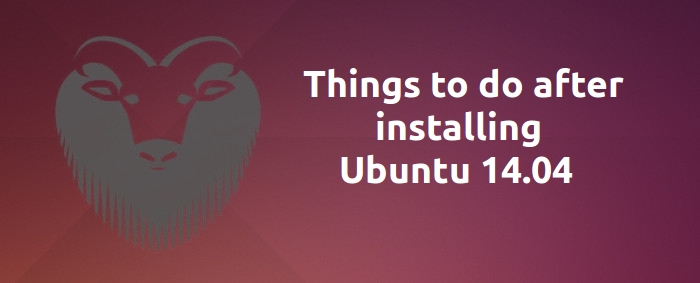
Change software sources and update your system:
First and foremost thing to do when you install Ubuntu is to change the software sources and add Canonical Partners in it. This will increase the number of applications and programs in your repository and you can easily install them via Ubuntu Software Center or command line.
Open Unity Dash (press Super/Windows key) and search for Software & Updates:

Open it and in Other Software tab, make sure that Canonical Partners is checked.
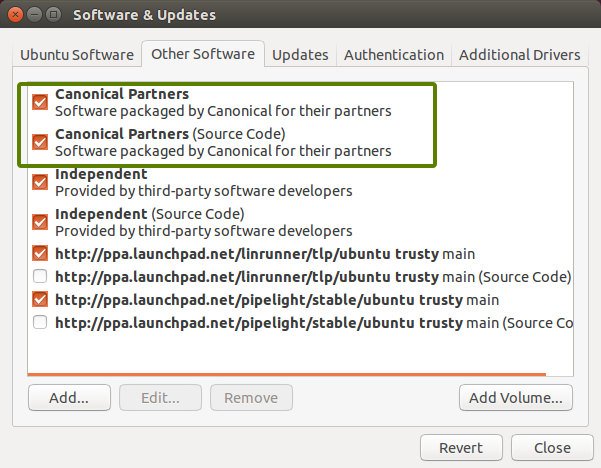
Doing this will update your repository. It takes some time in doing so. Once done, open terminal (Ctrl+Alt+T) and use the following command:
sudo apt-get update && sudo apt-get upgradeThe above command will update your system.
Install Ubuntu Restricted Extras for media codecs:
“Ubuntu restricted extras” is a package of several codecs that are not installed by default in Ubuntu system. The reason why these these codecs are not included by default is legal constraints in many countries. Canonical cannot include them by default but if you install these codecs, it is you who would be held responsible for the usage and not Ubuntu. Don’t worry it’s safe to install these codecs. With these codecs installed, you can play different media formats such as MP3, MP4, AVI and several other formats without any trouble. Install it using the following command:
sudo apt-get install ubuntu-restricted-extrasNote: For beginners, if you see EULA screen, press TAB to switch between options and use Enter to confirm a choice.
Install Adobe Flash player:
Normally after installing Ubuntu Restricted Extras, you should be able to play videos that run Adobe flash player such as You Tube videos. But for one reason or other you may have issues with Flash Player. To install Adobe Flash Player in Ubuntu 14.04, use the following command:
sudo apt-get install flashplugin-installerEnable edge scrolling
Staring with Ubuntu 13.10, two finger scroll is enabled by default. Which means the normal (and more popular) edge scroll will not work on your laptop’s touchpad. To enable edge scrolling, go to System Settings->Mouse & Touchpad and un-check the option of Two finger scroll.
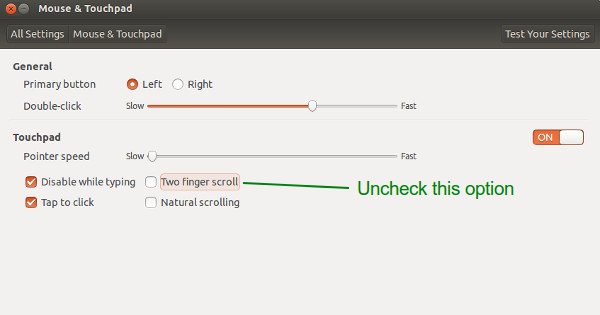
If you are facing issues, follow the screenshot tutorial to enable edge scrolling in Ubuntu.
Install Dropbox and fix the indicator issue
Ubuntu One cloud service for files is being discontinued. Which leaves us with Dropbox and Google Drive as main cloud storage services in Ubuntu. While Google Drive does not have an official Linux client, Dropbox is still the best bet when it comes to desktop Linux. Use the command below to install Dropbox in Ubuntu:
sudo apt-get install nautilus-dropboxAlternatively, you can download the installer from their website. One of the issue that you might face is the missing Dropbox indicator in the top panel. To bring back the Dropbox indicator back, use the following command:
sudo apt-get install libappindicator1Once installed, restart the computer. Drobox icon should be back in top panel.
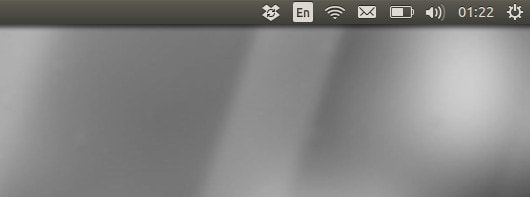
Remove keyboard input from Unity Panel
For some reasons, Ubuntu started to put the keyboard input indicator by default in the top panel. While it could be useful for some people who change their keyboard layout frequently, it certainly is of no use to me. For me, it unnecessarily takes space in the top panel. If you find it annoying as well, disable it from System Settings-> Text Entry and uncheck the Show current input source in the menu bar.
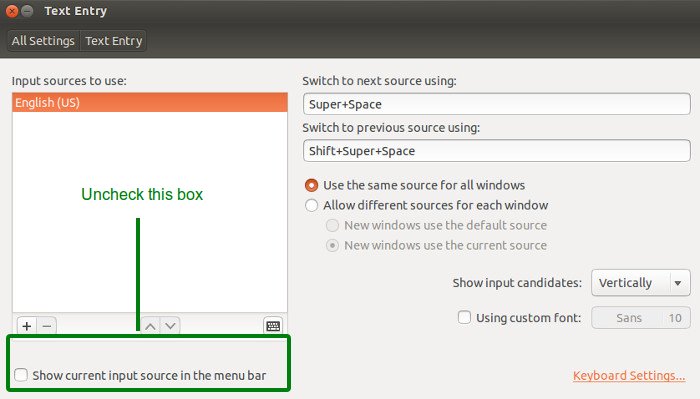
Fix brightness issue [For Intel graphics]
Don’t worry, you are not the only who find Ubuntu too bright and you are definitely not the only one who cannot reduce the brightness in your laptop using the function keys. It’s a known bug which is ‘ported successfully’ in Ubuntu 14.04. If your video driver is Intel, you can easily fix the brightness control issue in Ubuntu.
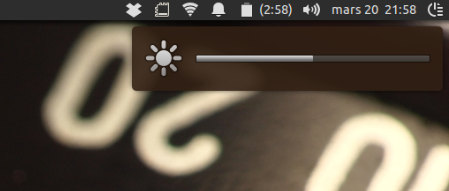
Install VLC media player:
Let me confess, I cannot imagine using my personal computer without VLC media player. It’s the best out there. It can download subtitles automatically, you can manually synchronize the subs, you can watch online videos with subtitles with VLC and now you can enable desktop notification for VLC in Ubuntu. Use the following command to install VLC:
sudo apt-get install vlcPlay encrypted DVD in Ubuntu 14.04:
Enable encrypted DVD playback in Ubuntu 14.04 using the following commands:
sudo apt-get install libdvdread4
sudo /usr/share/doc/libdvdread4/install-css.shIf you are facing problems with playing DVDs altogether, read this article to play DVDs with VLC in Ubuntu.
Install RAR:
To avoid error like “There is no command installed for RAR archive files“ install RAR using the following command:
sudo apt-get install rarInstall additional drivers in Ubuntu 14.04:
Ubuntu provides some third part propriety drivers for wireless, graphics cards etc. If you are facing problems with them, try to install these additional drivers. You can find additional drivers available for your system in Software & Updates, under Additional Drivers tab:
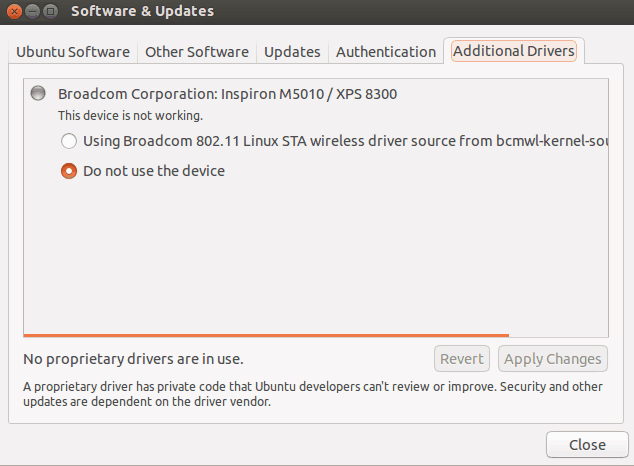
Improve battery life and reduce overheating:
Overheating of laptops is a common issue, not only in Ubuntu but in any operating systems. Overheating also affects the battery life. Until Ubuntu 12.10, Jupiter was the best tool to reduce overheating, but since its development has stopped, you can use TLP or CPUFREQ instead of Jupiter. Install TLP using the following command:
sudo add-apt-repository ppa:linrunner/tlp
sudo apt-get update
sudo apt-get install tlp tlp-rdw
sudo tlp startAnd that’s it. No configuration is required for using TLP. For CPUFREQ, read this best practices to stop laptop overheating in Linux.
Tweak Unity and Gnome:
Not satisfied with the default looks of Ubuntu 14.04? You can always tweak it. Ubuntu System Settings gives you plenty of option for tweaking, Unity Tweak Tool and Gnome Tweak Tool (for Gnome users) are excellent tools to tweak the appearance to any extent.
sudo apt-get install unity-tweak-toolsudo apt-get install gnome-tweak-toolDisable shopping suggestions:
There has been huge uproar over privacy issues in Ubuntu. If you don’t want to see the shopping suggestions and want to preserve your privacy, use the following command in a terminal:
gsettings set com.canonical.Unity.Lenses disabled-scopes "['more_suggestions-amazon.scope', 'more_suggestions-u1ms.scope', 'more_suggestions-populartracks.scope', 'music-musicstore.scope', 'more_suggestions-ebay.scope', 'more_suggestions-ubuntushop.scope', 'more_suggestions-skimlinks.scope']"Install Java in Ubuntu 14.04:
I know there are many people who don’t like Java for one reason or other but mostly you will require to have Java installed in your system. To install Java in Ubuntu 14.04, use the following command:
sudo apt-get install icedtea-7-plugin openjdk-7-jreThere are more ways to install Java in Ubuntu 14,04, other than the one listed here.
This is definitely not the end of the story. There are plenty more things to do after installing Ubuntu 14.04 but if I keep on going it will be a never ending list. I hope you find this article helpful, especially the beginners. You can find more helpful articles to get you started with Ubuntu 14.04.
What is your must to do list after a fresh Ubuntu install? Would you like to add something essential which is perhaps missing here? Do share your views.

